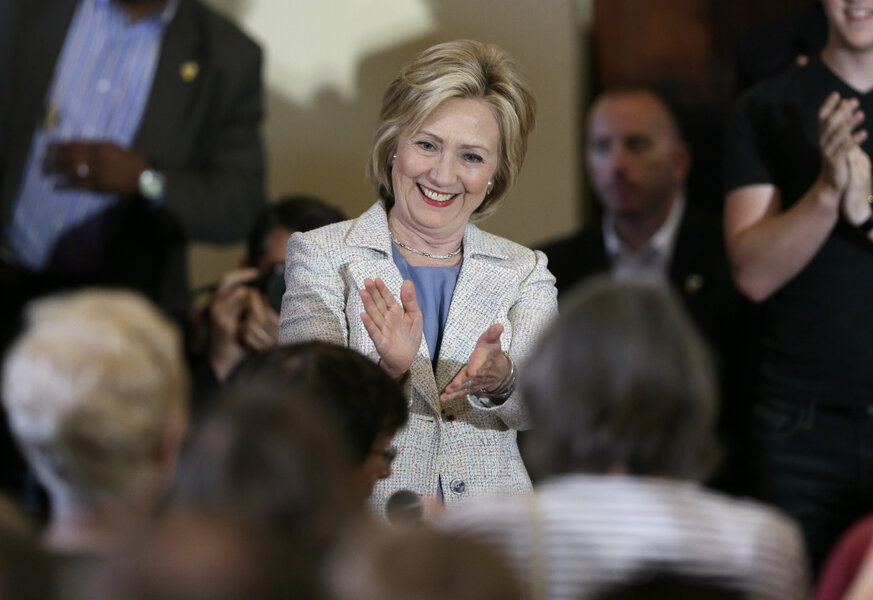Hillary Clinton has big plans for solar power. Are they achievable?
Loading...
Hillary Clinton sees your plans for a clean-energy future and raises you a few hundred-million solar panels.
The Democratic presidential frontrunner rolled out an ambitious plan late Sunday to decarbonize the US power sector, the first of what her campaign says will be a series of energy and climate policy announcements.
Although light on details, Mrs. Clinton’s plan sets high targets for renewable energy deployment and goes further than energy policies put in place by President Obama – the first occupant of the Oval Office to take direct executive action on climate change. The plan is an attempt to fend off critics from the left who say the former secretary of state has been slow make climate a part of her campaign. It also puts Clinton in stark contrast to Republican candidates, the majority of whom either avoid discussing mainstream climate science or dismiss it outright.
“I’m just a grandmother with two eyes and a brain, and I know what’s happening in the world is going to have a big effect on my daughter, and especially on my granddaughter,” Clinton says in a video unveiling the climate plan. “It’s hard to believe there are people running for president who still refuse to accept the settled science of climate change – who would rather remind us ‘they’re not scientists’ than listen to those who are.”
The US will install more than a billion solar panels by 2020, according to Clinton’s plan, raising total installed capacity from today’s 21 gigawatts to 140 gigawatts. That represents a 700 percent increase over four years. As Vox’s Brad Plumer points out, that’s a big number, but not entirely implausible. Between 2010 and 2014, solar capacity grew by 418 percent, according to the US Energy Information Administration.
The plan also calls for the US to generate enough renewables to power every US home by 2027. That equates roughly to generating a third of US electricity from wind, solar, and other renewable sources – up from 13 percent today. It also goes beyond the 25 percent of electricity generation from renewables that is projected to come with President Obama’s proposed Clean Power Plan. That plan, which would regulate carbon emissions from US power plants for the first time in the nation’s history, is being challenged in Congress and in court. If elected president, Clinton says she will defend the plan from its critics.
“The Clean Power Plan is a crucial tool in our national strategy to reduce carbon pollution, level the playing field for and increase the deployment of renewable energy, and build a clean energy future,” the campaign’s fact sheet reads. “But smart federal standards set the floor, not the ceiling. We can and must go further.”
Deep-pocketed environmentalist donors are expected to play a large role in this election cycle. Billionaire investor and climate activist Tom Steyer has urged presidential candidates to adopt a target of generating half of US power from carbon-free sources by 2030. Clinton’s plan would bring her platform in line with that target or potentially exceed it, assuming nuclear generation remains flat or even grows.
The plan is expected to cost around $60 billion, according to a campaign spokesman, to be offset by eliminating tax breaks for the oil and gas industry.
The question, then, is whether or not Clinton’s vision is both technically feasible and politically viable. Most analysts suggest that a significant decarbonization of US energy supply over the coming decades would be challenging, but certainly within the realm of possibility. The technology for carbon-free power generation already exists – it’s a matter of deploying those technologies and ensuring they work in harmony to create a stable grid.
Indeed, “it is technically feasible to achieve an 80% greenhouse gas reduction below 1990 levels by 2050 in the United States,” according to a joint study released last fall by the consultancy Energy and Environmental Economics, Lawrence Berkeley National Lab, and Pacific Northwest National Laboratory. The study outlines several different pathways to meet that target that rely on different generation mixes and estimates the incremental cost of such an endeavor to be less than 1 percent of US GDP.
It’s harder to say whether or not such a plan is politically viable. Cap-and-trade bills that would put a price on carbon have been largely a non-starter in Congress, and executive actions are vulnerable to legal and Congressional challenges. But there are some signs that public support for climate policies is growing, which could shift how presidential candidates view the issue. Forty-six percent of Americans say that global warming is a serious problem, according to a June survey by Pew Research Center. That’s an increase of 13 percentage points from spring of 2013.






